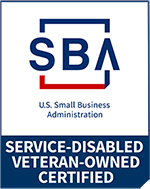Procurement and Logistics Office, Front Office Support
Client:
Veterans Health Administration (VHA), Procurement & Logistics Office (P&LO)
Challenge:
P&LO is responsible for providing oversight and management of VHA’s supply chain to ensure the right product is available at the right price and at the right time for Veteran health care. P&LO is also working to modernize the Department of Veterans Affairs (VA) supply chain operations and enhance readiness to all hazards, including support of VA’s Fourth Mission as the nation’s backup health care system, while it manages annual expenditures of more than $15B. The Office of Procurement is comprised of three Regional Procurement Offices that support purchasing and contracting capabilities for VHA’s 1,300 facilities located throughout the United States. Prior to COVID-19, the provision of medical products – including personal protective equipment (PPE) – to hospitals, clinicians, and patients depended upon a globally integrated supply chain designed to provide Just-in-Time (JIT) delivery. JIT, and the lean manufacturing practices it relied upon, cut cost by reducing the amount of stock held at every link in the supply chain from raw material providers to the patient’s bedside. COVID-19 underscored P&LO’s need to develop an integrated VA enterprise-wide supply chain, develop and implement an enterprise-wide strategy, and modernize key elements of VA’s supply chain operations.
Approach:
The team provided support for program management, strategic planning, data management and dashboarding, correspondence/actions management, Planning, Programming, Budgeting, and Execution (PPBE) implementation, and communications support. They worked with P&LO leaders to synchronize and distribute strategic communications, as well as manage organizational change products and messaging for internal and external stakeholders, including leaders and staff within the P&LO, VA Central Office, frontline employees, Congress, Government Accountability Office (GAO), Office of Inspector General (OIG), and industry.
Results:
The team has assisted VHA P&LO provide oversight and management of VHA’s supply chain by:
- Program Management Operations – At the onset of COVID-19 in March 2020, the team quickly responded by providing direct on-site support in the planning, deployment, and management of the P&LO’s emergency Logistics Operations Center (LOGOPS). The team developed standard operating procedures (SOPs) for the collective P&LO LOGOPS team and established a practical and feasible “battle rhythm” cadence spanning seven days per week, 24 hours per day, and provided on-site support with adaptive team members across multiple shifts. The team led the daily LOGOPS meetings and supported the consolidation of data and reporting into executive presentations for the P&LO leadership and VHA stakeholders.
- Communications – The team supported P&LO in standing up communication mechanisms to respond to, track, and report on Requests for Information (RFIs) received from Congress, the media, and regulatory entities such as the Government Accountability Office and Office of Inspector General. Given media attention around the global shortage of PPE, the VHA supply chain became a primary topic for RFIs. The team developed a system to track RFIs from cradle to grave. This RFI tracking system established a central repository that could be used to glean frequently asked questions, trends, and lessons learned, as well as determine topics for regular, ongoing communications.
- Data Analysis and Reporting – The team supported P&LO in organizing, designing, developing, implementing, and maintaining executive and field level systems related to COVID-19 task and communications tracking. The team deployed integrated solutions within existing VHA assets including the complete integrated deployment of products directly within the VHA environment to include Microsoft SharePoint, Teams, and Outlook. The team also developed a SharePoint list-based data repository capable of storing multilayered information for use within data model calculations. The tracking of overall task status, information, and attachments all consolidated within a single point-of-contact tool, optimized for ease of use, and provided complete transparency. The team leveraged the data collected within the SharePoint data repository to generate a data model and subsequent dashboard product using PowerBI. Once deployed, the team developed an automated maintenance function, which allowed data to flow seamlessly from the data-entry product to the data.

